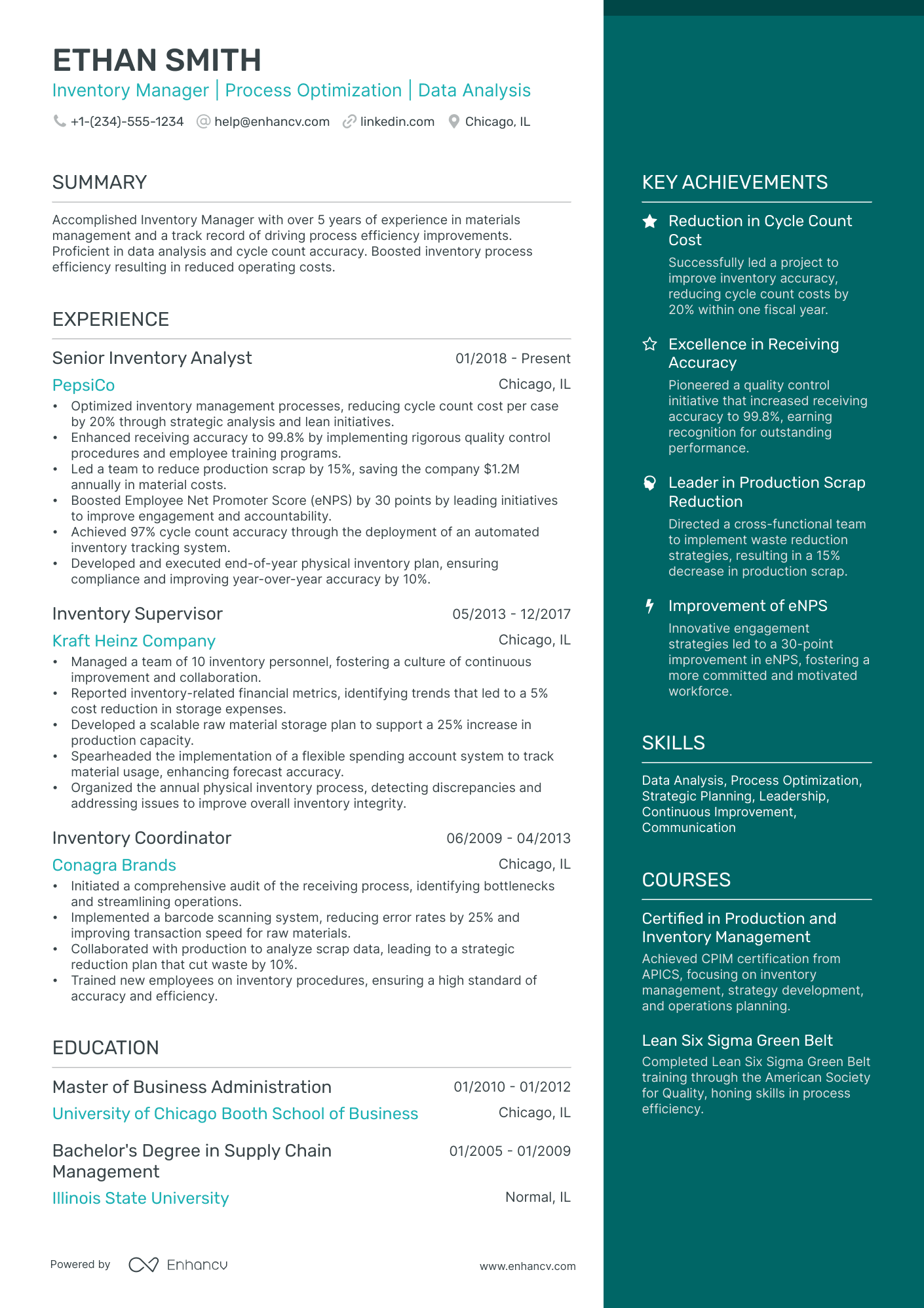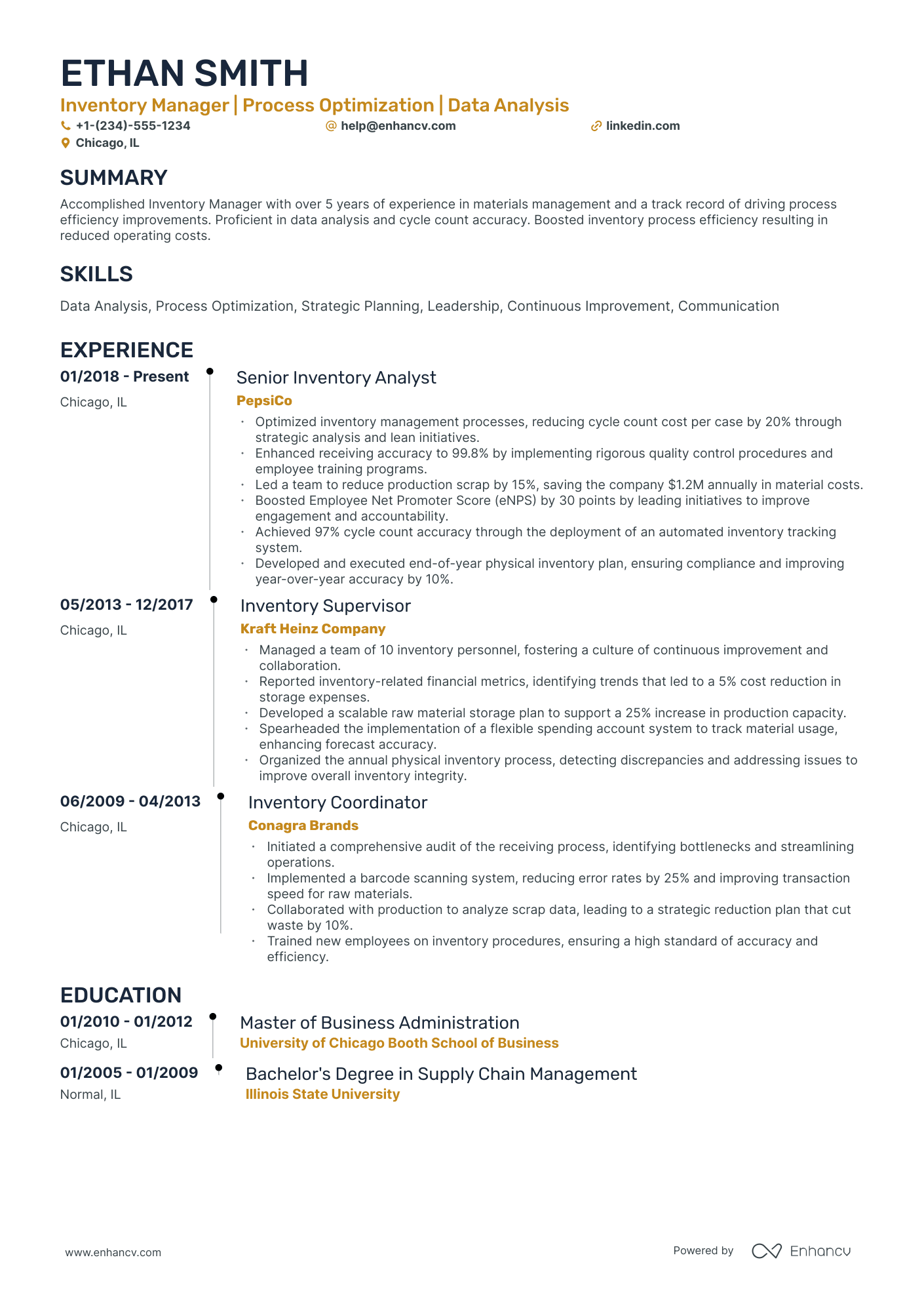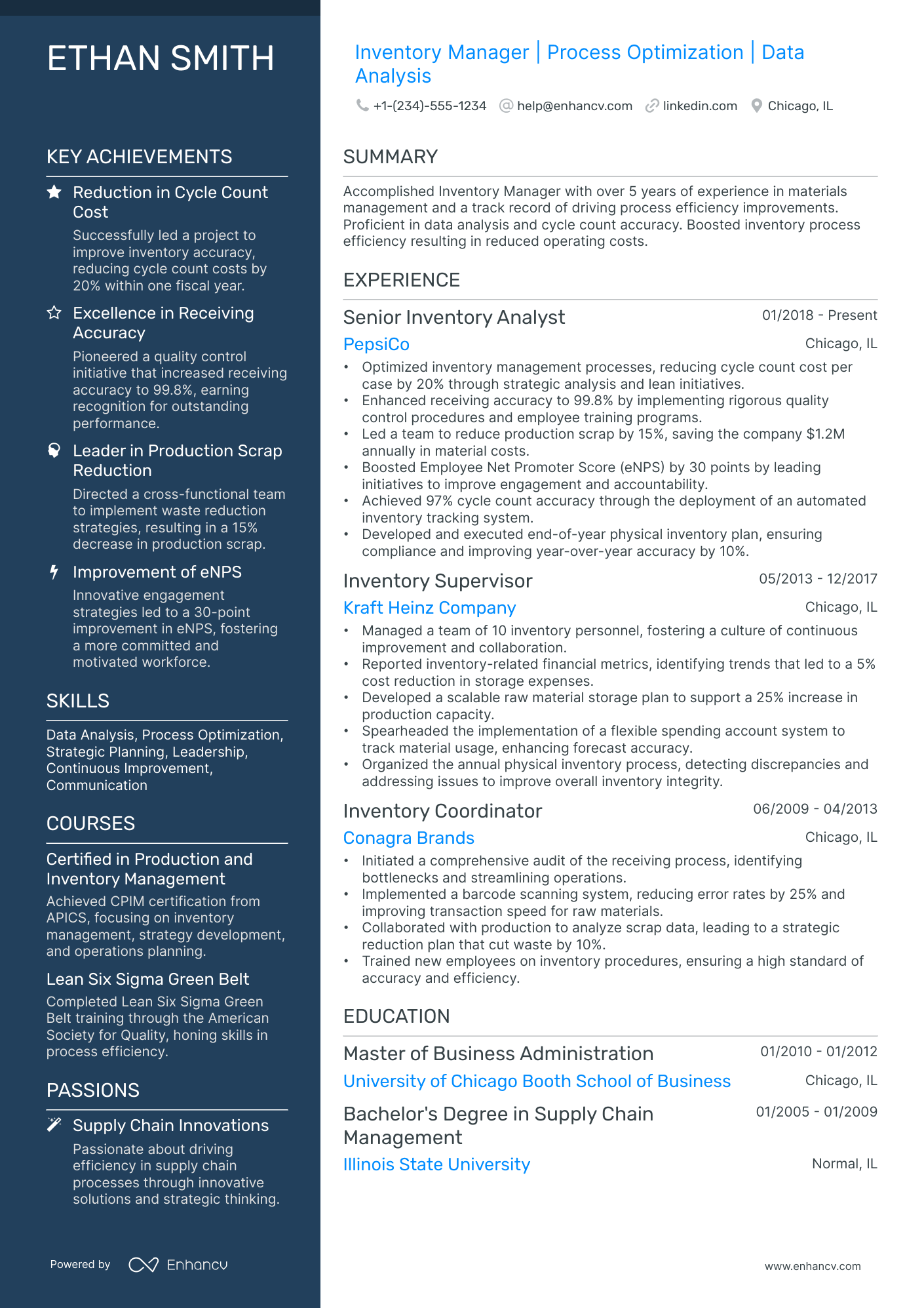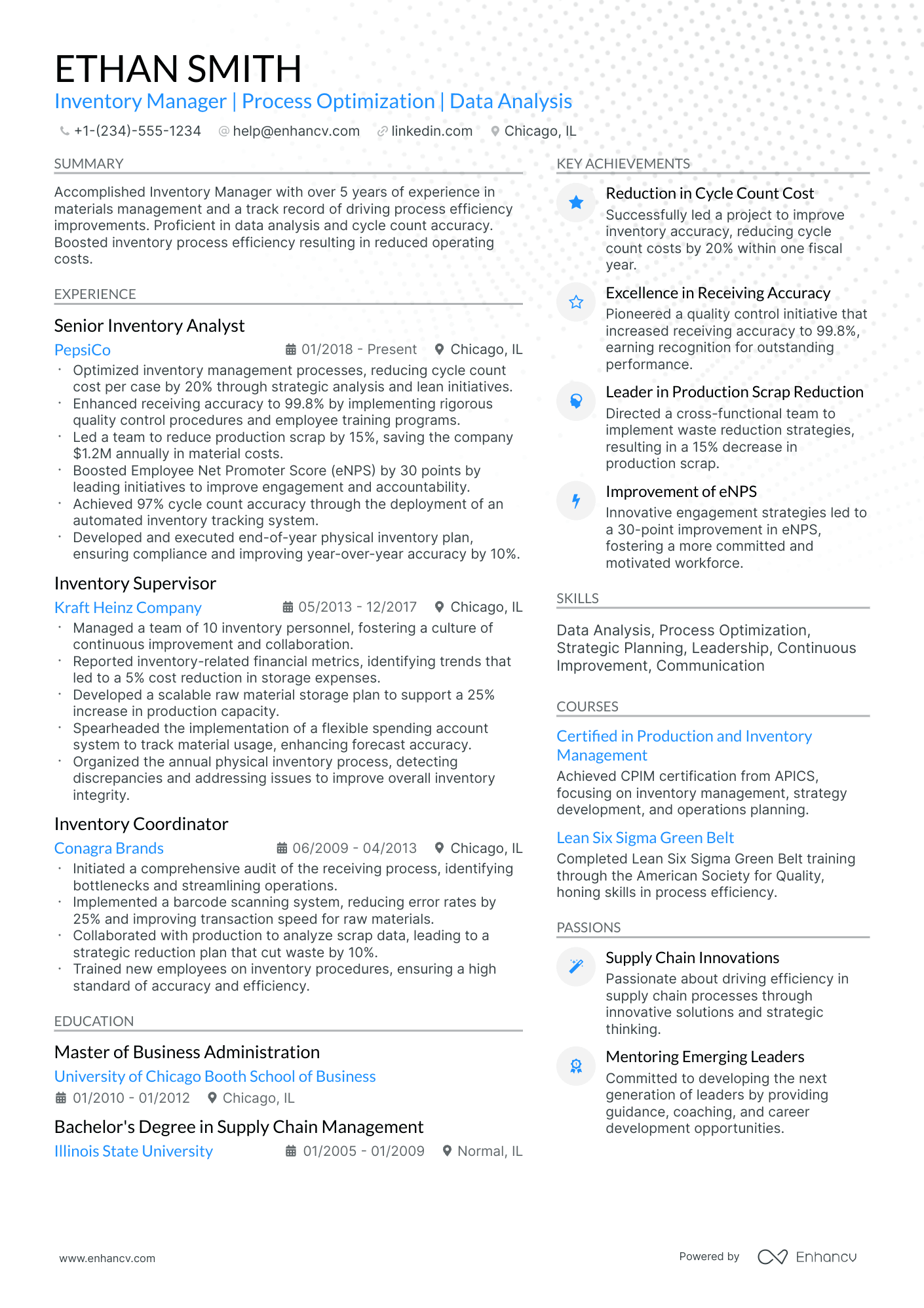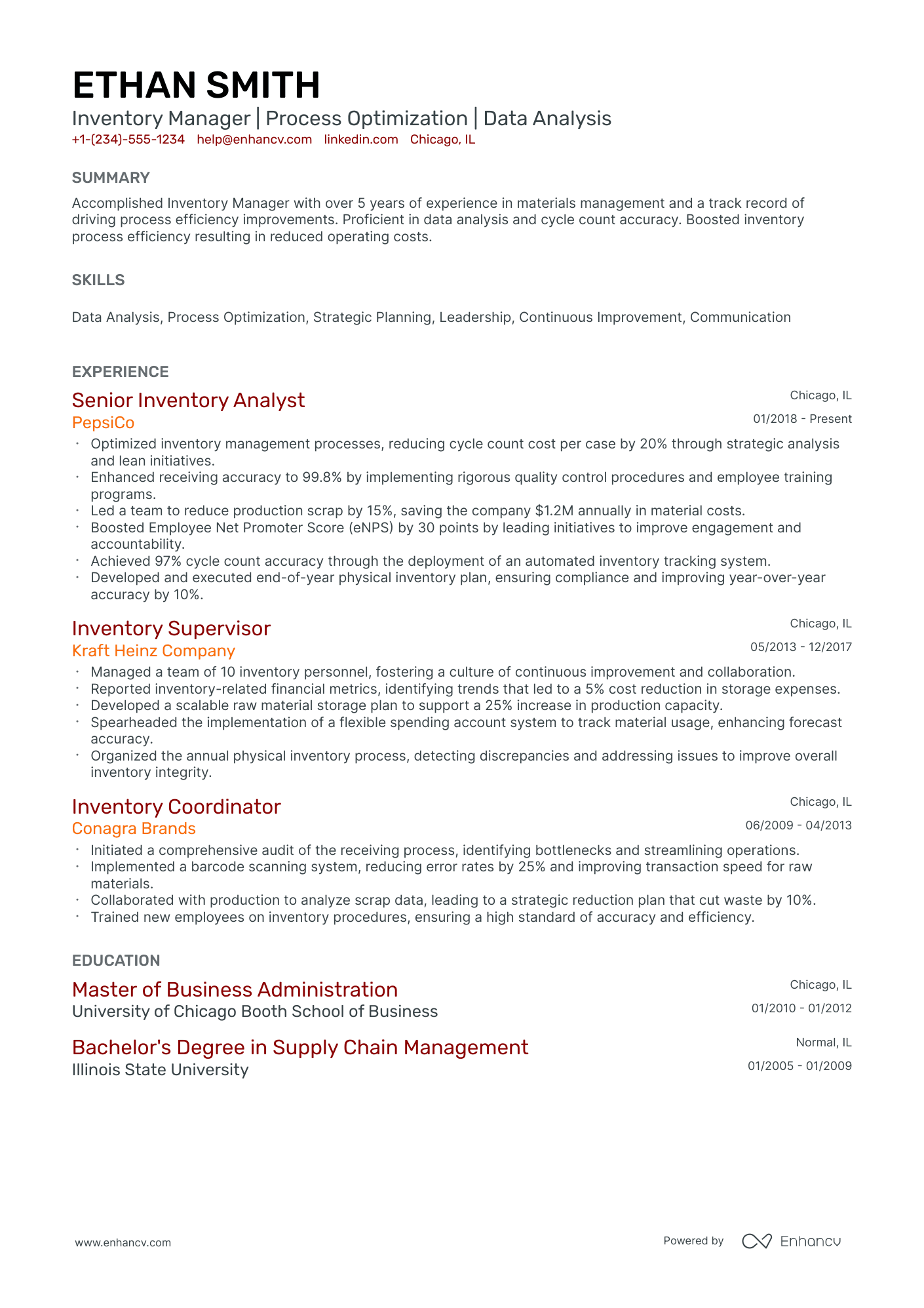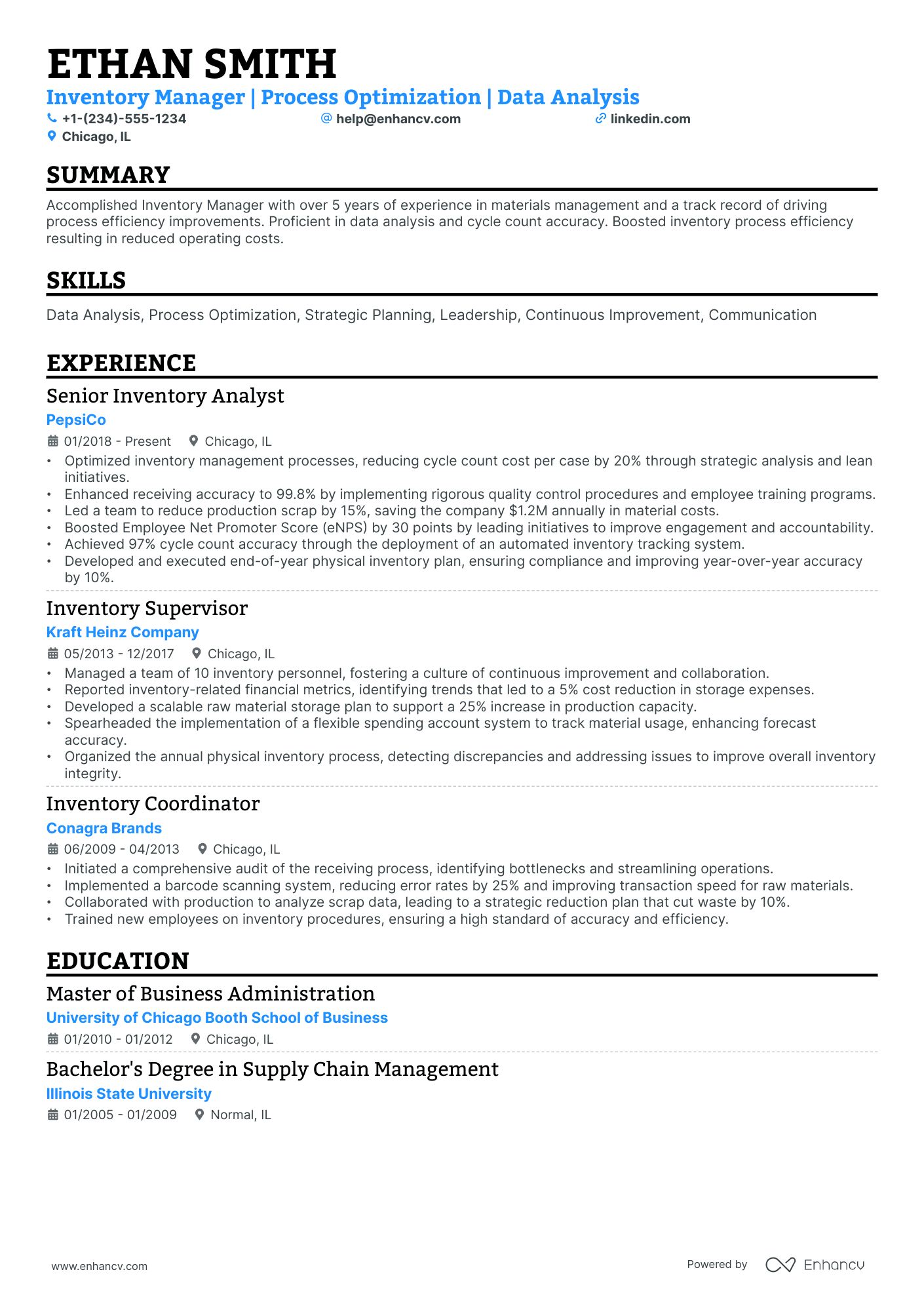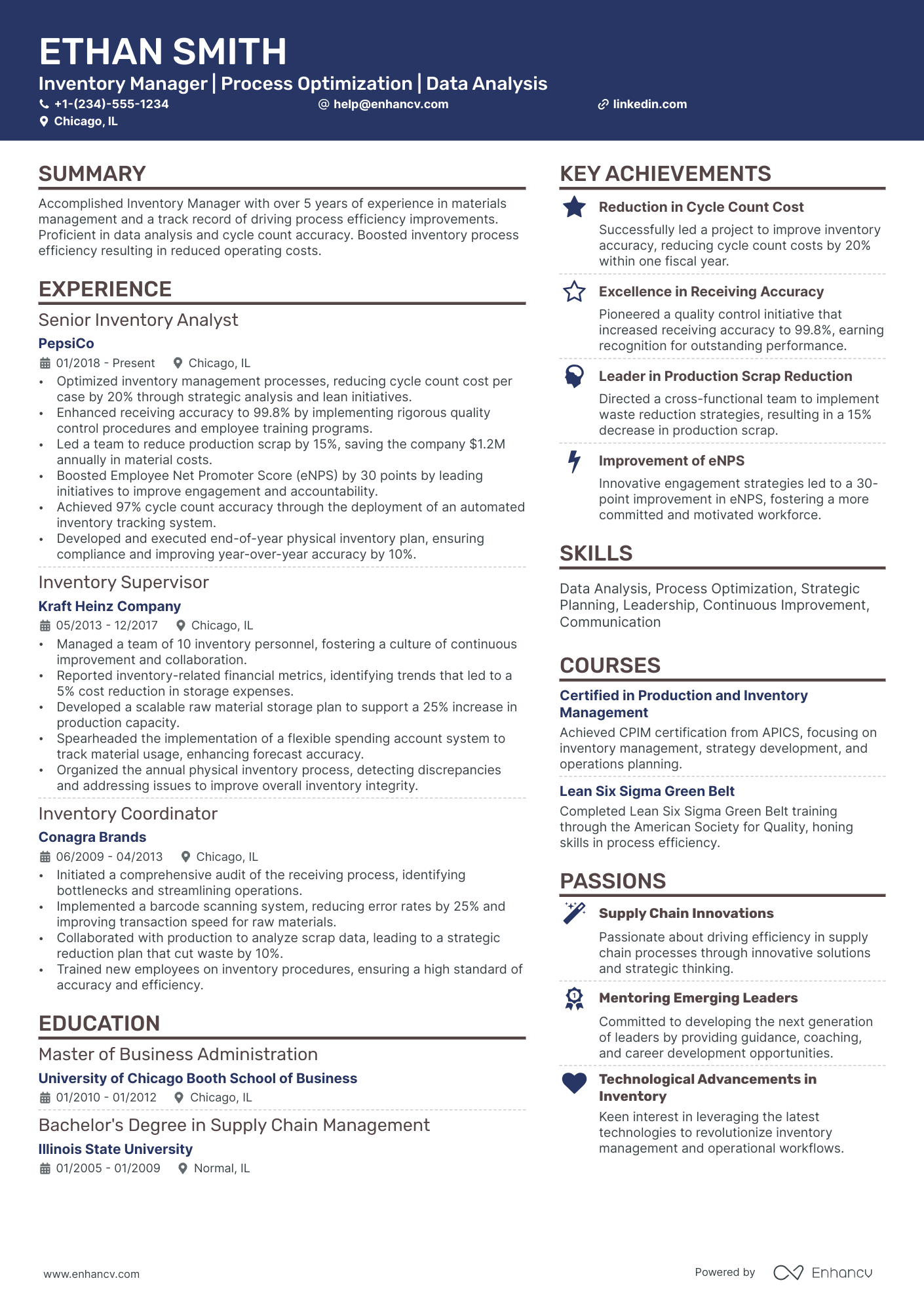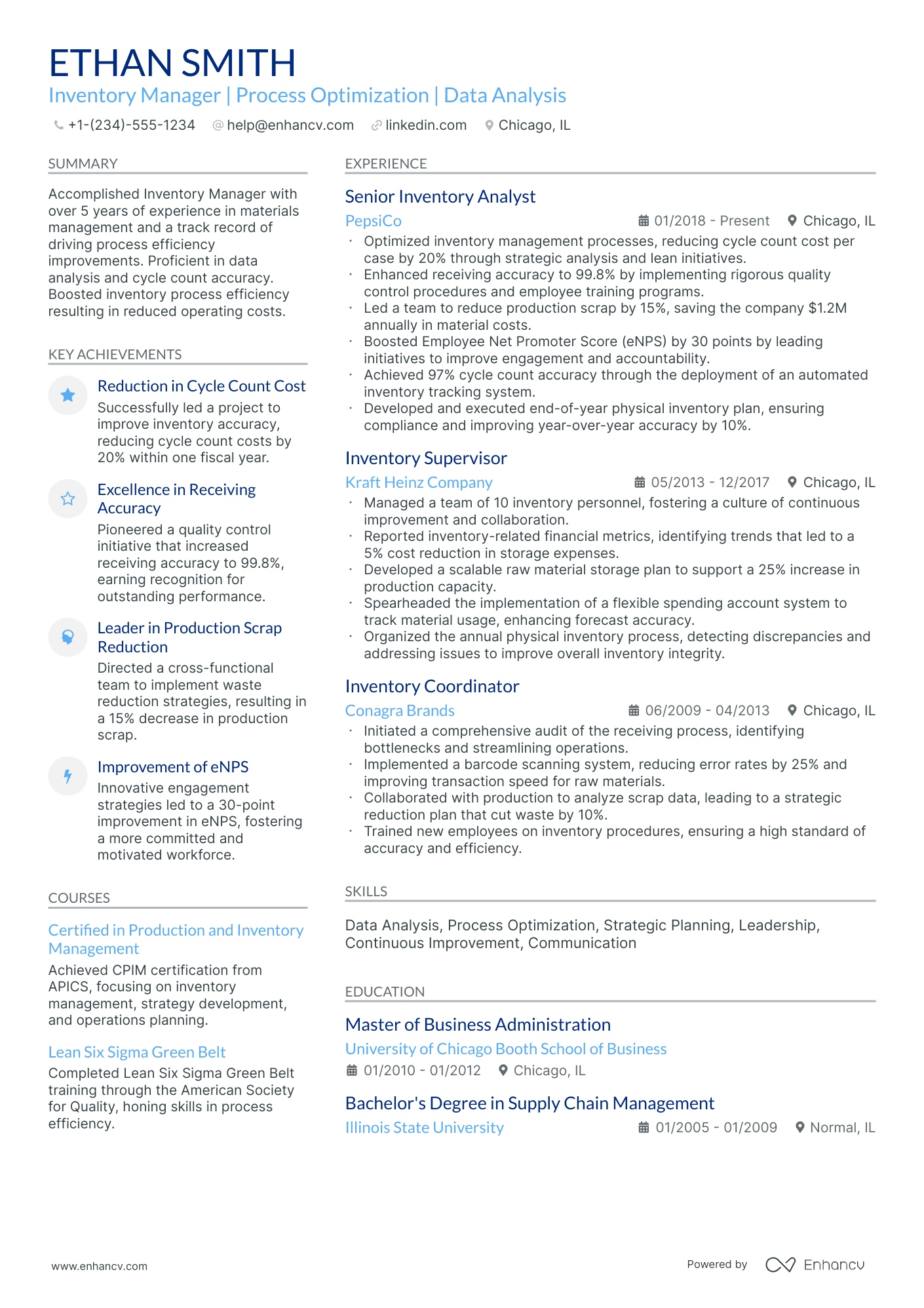As an inventory manager, you might struggle with articulating the complexity of your inventory management skills in a concise, yet comprehensive manner on your resume. Our guide offers tailored strategies to effectively showcase your inventory management expertise, ensuring your key accomplishments stand tall to impress potential employers.
- Sample industry-leading examples to learn how to write your best resume yet.
- Improve the experience, education, and achievements section of your resume with insights from resume-writing professionals.
- Curate your technical expertise and personality to stand out amongst the pool of candidates.
- Succinctly focus on your unique skill set all through your inventory manager resume.
If the inventory manager resume isn't the right one for you, take a look at other related guides we have:
- Fleet Manager Resume Example
- Supply Chain Manager Resume Example
- Assistant Production Manager Resume Example
- Packaging Manager Resume Example
- Machinist Resume Example
- Logistics Coordinator Resume Example
- Inventory Resume Example
- Field Manager Resume Example
- Farm Manager Resume Example
- Delivery Manager Resume Example
Simple guide to your inventory manager resume format and layout
Successful inventory manager resumes all have one specific characteristic - candidates have invested in a simple resume layout . One that is easy to read, makes a good first impression, and is adapted to their professional experience. There are three distinct resume formats to help you focus on your:
- professional experience - use the reverse-chronological resume format;
- skills and achievements - via the functional skill-based resume format;
- both experience and skills - with a hybrid resume format .
What is more, keep in mind that your resume may be initially assessed by the ATS (Applicant Tracker System) (or the software used by companies in the hiring process). The inventory manager resumes that suit the ATS:
- have a header that includes either a role keyword or the job you're applying for;
- should be no longer than two pages;
- be submitted as PDF, unless specified otherwise.
Keep in mind market-specific formats – for example, a Canadian resume might follow a different structure.
Upload & Check Your Resume
Drop your resume here or choose a file. PDF & DOCX only. Max 2MB file size.
PRO TIP
Showcase any ongoing or recent educational efforts to stay updated in your field.
Don't forget to include these six sections on your inventory manager resume:
- Header and summary for your contact details and to highlight your alignment with the inventory manager job you're applying for
- Experience section to get into specific technologies you're apt at using and personal skills to deliver successful results
- Skills section to further highlight how your profile matches the job requirements
- Education section to provide your academic background
- Achievements to mention any career highlights that may be impressive, or that you might have missed so far in other resume sections
What recruiters want to see on your resume:
- Proven track record of successful inventory management, including inventory forecasting, stock optimization, and inventory turnover rates.
- Experience with inventory management systems and proficient use of related software like SAP, Oracle, or warehouse management systems.
- Strong analytical skills to analyze stock levels, predict inventory needs, and prevent overstocking or stockouts.
- Knowledge of supply chain management principles and the ability to coordinate with suppliers, purchasing, and logistics to ensure inventory accuracy and availability.
- Demonstrated leadership skills and the ability to manage and oversee a team of inventory clerks or warehouse staff to ensure that inventory processes are carried out correctly and efficiently.
What is the resume experience section and how to write one for your past roles
The experience section in a inventory manager resume is critical for your profile and overall application. It should not only display your work history, but also highlight your achievements in previous roles.
Many candidates either simply list their duties or provide excessive details about past, irrelevant jobs. A more effective approach involves first examining the job advertisement for keywords - specifically, skills essential for the role. Then, demonstrate these key requirements throughout different parts of your resume, using accomplishments from your roles.
Format each bullet point in your experience section by starting with a strong action verb. Follow this with a description of your role and its impact on the team or organization.
Aim to include three to five bullet points for each role.
Finally, gain insights into how professionals have crafted their inventory manager resume experience sections by exploring some best practice examples.
- Implemented a new inventory tracking system using barcode technology, which decreased inventory errors by 25% within the first year of implementation.
- Negotiated with suppliers to secure bulk purchase discounts, reducing material costs by 15% while maintaining quality standards.
- Collaborated with the sales and logistics teams to forecast demand more accurately, which improved stock availability by 30% and minimized overstock situations.
- Managed a team of 10 inventory assistants, reinforcing a culture of continuous improvement that led to a reduction in inventory cycle time by 20%.
- Streamlined receiving and dispatch processes that increased warehouse operational efficiency by 18%, directly impacting customer satisfaction through faster order fulfillment.
- Coordinated annual inventory audits, identifying discrepancies and implementing solutions that reduced inventory shrinkage by 2%.
- Leading a cross-departmental initiative to transition to a cloud-based inventory system, increasing real-time visibility of stock levels across 15 national outlets.
- Directed the shift towards a just-in-time inventory model, significantly reducing holding costs and freeing up warehouse space by 40%.
- Orchestrated an inventory optimization project that balanced stock levels with predictive analytics, resulting in a 10% increase in inventory turnover ratio.
- Spearheaded a staff development program that improved inventory accuracy through better employee training, thereby enhancing stock record integrity by 22%.
- Initiated vendor performance evaluations contributing to a 12% improvement in supply chain reliability and inventory availability.
- Executed a successful pilot program for RFID tagging on high-value items, which reduced search and retrieval time by 35%, enhancing productivity.
- Developed a centralized inventory database that facilitated better decision-making regarding stock disposal and replenishment, decreasing carrying costs by 8% annually.
- Led a team of inventory analysts in developing reporting tools that provided insights into sales trends, aiding in the launch of three successful product lines.
- Designed and implemented a successful consignment inventory system with key suppliers, which optimized stock levels and improved cash flow by 15%.
- Introduced automated demand forecasting models that enhanced reordering processes, leading to a 20% decrease in backorder incidents and enhancing customer satisfaction.
- Pioneered a waste reduction initiative by reallocating slow-moving inventory, leading to a 5% reduction in overall inventory waste.
- Managed end-of-life product strategies that maximized returns from aged stock, adding an annual average of $100,000 in recovered revenue to the bottom line.
- Orchestrated the integration of an AI-powered inventory forecasting tool, which reduced overstock situations by 20% and aligned inventory holding with market demand.
- Championed a supplier partnership program, which involved collaborative planning and replenishment strategies, bolstering supply chain resilience during high-demand periods.
- Implemented environmental sustainability practices in inventory management, achieving a 10% reduction in the company’s carbon footprint through improved packaging and transportation practices.
- Reengineered the spare parts inventory system for manufacturing operations, dramatically reducing machine downtime by ensuring a 95% availability of critical spares.
- Facilitated cross-functional team meetings to create alignment between procurement, warehousing, and sales, leading to a 5% improvement in end-to-end inventory management metrics.
- Oversaw the establishment of a central inventory hub, streamlining stock distribution to regional warehouses and resulting in a 12% reduction in inter-warehouse transfer costs.
Quantifying impact on your resume
- Managed an inventory worth over $500,000, demonstrating strong financial oversight and asset management skills.
- Reduced inventory holding costs by 15% through strategic planning and optimization of storage methods.
- Implemented a new inventory management system that increased tracking efficiency by 25%.
- Conducted quarterly audits, identifying and rectifying a 98% accuracy rate in inventory records.
- Trained a team of 10 inventory staff, improving overall productivity and accuracy of inventory processing.
- Led a successful inventory reduction initiative, cutting excess stock by 20% without impacting product availability.
- Negotiated with suppliers to improve reorder efficiency, resulting in a 10% reduction in lead times.
- Developed inventory forecasting models that reduced out-of-stock situations by 30%, ensuring better customer service.
Action verbs for your inventory manager resume
What if you don't have any experience?
There are two very common scenarios about candidates with less experience. They are either:
- Fresh out of college in search of a inventory manager role
- Transferring over from a completely different field
Both of these types of candidates still have a shot at landing their first job in the industry.
All they need to do about the experience section of their inventory manager resume is:
- Consider their strengths - would the outcomes of their previous roles or niche skill sets impress recruiters? Feature those towards the top of your resume
- Exclude any and all irrelevant experience items - remember that at the end of the day, you're telling a story that aims to align with the ideal candidate for the inventory manager job
- Win recruiters over with personality - perhaps your ambition, dreams, and diligence would make you the perfect fit for the inventory manager role. Dedicate resume space to detail your personality traits by showcasing how they've helped you succeed in past roles
- Tailor your experience to specific job requirements - ensure your inventory manager resume answers the advert in the best way possible.
Recommended reads:
PRO TIP
If you're in the process of obtaining your certificate or degree, list the expected date you're supposed to graduate or be certified.
Featuring your hard skills and soft skills on your inventory manager resume
The skills section of your inventory manager resume needs to your various capabilities that align with the job requirements. List hard skills (or technical skills) to showcase to potential employers that you're perfectly apt at dealing with technological innovations and niche software. Meanwhile, your soft skills need to detail how you'd thrive within your new, potential environment with personal skills (e.g. resilience, negotiation, organization, etc.) Your inventory manager resume skills section needs to include both types of skills to promote how you're both technical and cultural fit. Here's how to create your bespoke inventory manager skills section to help you stand out:
- Focus on skill requirements that are listed toward the top of the job advert.
- Include niche skills that you've worked hard to obtain.
- Select specific soft skills that match the company (or the department) culture.
- Cover some of the basic job requirements by including important skills for the inventory manager role - ones you haven't been able to list through the rest of your resume.
Get inspired with our inventory manager sample skill list to list some of the most prominent hard and soft skills across the field.
Top skills for your inventory manager resume:
Inventory Management Software
ERP Systems
Microsoft Excel
Barcode Scanning Technology
Demand Forecasting Tools
Supply Chain Management Software
Data Analysis Tools
Warehouse Management Systems
SQL
Inventory Optimization Techniques
Attention to Detail
Organizational Skills
Problem-Solving
Communication Skills
Time Management
Analytical Thinking
Team Collaboration
Adaptability
Negotiation Skills
Leadership
PRO TIP
List all your relevant higher education degrees within your resume in reverse chronological order (starting with the latest). There are cases when your PhD in a particular field could help you stand apart from other candidates.
Discover the perfect certification and education to list on your inventory manager resume
Value the insights your resume education section offers. It can shed light on various proficiencies and experiences tailored for the job.
- Add only college or university degrees, stating the institution and duration.
- If you're nearing the end of your degree, note your graduation date.
- Weigh the pros and cons of including unrelated degrees - it might not be your best choice with so little space on your resume.
- Talk about your educational achievements if they amplify your relevant experience.
There are so many certificates you can list on your resume.
Just which ones should make the cut?
- List your prominent higher education degree in a separate box, alongside the name of the institute you've obtained it from and your graduation dates
- Curate only relevant certificates that support your expertise, hard skills, and soft skills
- Certificates that are more niche (and rare) within the industry could be listed closer to the top. Also, this space could be dedicated to more recent certifications you've attained
- Add a description to your certificates or education, only if you deem this could further enhance your chances of showcasing your unique skill set
When listing your certificates, remember that it isn't a case of "the more, the merrier", but rather "the more applicable they are to the industry, the better".
Recruiters have hinted that these are some of the most in-demand certificates for inventory manager roles across the industry:
The top 5 certifications for your inventory manager resume:
- Certified in Production and Inventory Management (CPIM) – Association for Supply Chain Management (ASCM)
- Certified Supply Chain Professional (CSCP) – Association for Supply Chain Management (ASCM)
- Inventory Management Certification (IMC) – Institute for Supply Management (ISM)
- Certified Professional in Supply Management (CPSM) – Institute for Supply Management (ISM)
- Supply Chain Operations Reference Professional (SCOR-P) – APICS
PRO TIP
If you happen to have some basic certificates, don't invest too much of your inventory manager resume real estate in them. Instead, list them within the skills section or as part of your relevant experience. This way you'd ensure you meet all job requirements while dedicating your certificates to only the most in-demand certification across the industry.
Recommended reads:
Your inventory manager resume top one third: choosing between a resume summary or an objective
The top third of your resume is crucial, as recruiters might focus only on this section rather than reading the entire document. Therefore, it's important to carefully decide whether to include a resume summary or an objective.
- The resume summary encapsulates your most significant experiences, key achievements, and skills in the field. Ideal for candidates with substantial relevant experience, the summary previews what recruiters will find in the rest of your resume.
- The resume objective outlines your professional aspirations. It describes your career goals for the coming years and how you envision your role evolving in the prospective company. The resume objective is suitable if you have less professional experience and wish to emphasize various soft skills such as motivation, vision, and planning.
Explore some of the best examples of resume summaries and objectives from real-life professional resumes in the industry.
Resume summaries for a inventory manager job
- Dynamic inventory manager with over 10 years of experience overseeing multi-million-dollar stock levels for a leading retail chain. Adept at implementing cutting-edge inventory software, reducing waste by 25%, and spearheading a cross-departmental inventory accuracy program, resulting in a 30% improvement in stock management efficiency.
- Experienced logistics coordinator seeking to leverage 8 years of vendor management and supply chain optimization into inventory management. Excelled in demand forecasting and data analysis, achieving a 20% reduction in surplus inventory while maintaining a 98% product availability rate at a high-volume distribution center.
- Detail-oriented professional with a solid 5-year background in warehouse operations pivoting to inventory management. Built strong supplier relationships, mastering inventory control systems, and championed a warehouse reorganization project that boosted order fulfillment speed by 15% without increasing inventory holding costs.
- Former financial analyst with 6 years of experience managing asset portfolios, transitioning into inventory management. Bringing expertise in data-driven decision-making, statistical analysis, and process streamlining, recognized for enhancing stock turnover rates by applying analytical techniques to optimize inventory levels.
- Eager to embark on a career in inventory management, possessing keen analytical abilities, a Bachelor's degree in Business Administration, and a passion for operational excellence. Committed to learning from seasoned professionals and contributing to the creation of an advanced inventory system to maximize turnover and minimize stockouts.
- Aspiring to harness an educational foundation in supply chain management and an enthusiastic work ethic in an entry-level inventory manager role. Motivated by a fascination with inventory dynamics and a determination to contribute to seamless stock flow, while absorbing expert knowledge and mastering industry-leading inventory practices.
Recruiters' favorite additional inventory manager resume sections
When writing your inventory manager resume, you may be thinking to yourself, " Is there anything more I can add on to stand out? ".
Include any of the below four sections you deem relevant, to ensure your inventory manager resume further builds up your professional and personal profile:
Key takeaways
- Pay special attention to the tiny details that make up your inventory manager resume formatting: the more tailored your application to the role is, the better your chances at success would be;
- Select the sections you include (summary or objective, etc.) and formatting (reverse-chronological, hybrid, etc.) based on your experience level;
- Select experience items and, consequently, achievements that showcase you in the best light and are relevant to the job;
- Your profile will be assessed both based on your technical capabilities and personality skills - curate those through your resume;
- Certifications and education showcase your dedication to the particular industry.

